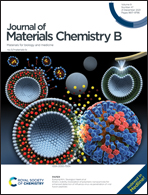Coacervate microdroplet protocell-mediated gene transfection for nitric oxide production and induction of cell apoptosis†
Abstract
Liquid coacervate microdroplets have been widely explored as membrane-free compartment protocells for cargo delivery in therapeutic applications. In this study, coacervate protocells were developed as gene carriers for transfection of nitric oxide synthase (NOS) and overproduction of nitric oxide (NO) for killing of cancer cells. The coacervate microdroplet protocells were formed via the liquid–liquid phase separation of oppositely charged diethylaminoethyl–dextran/polyacrylic acids. The coacervate microdroplet protocells were found to facilitate gene transfection, which was demonstrated by cell imaging of the internalized coacervate microdroplets containing plasmids of enhanced green fluorescent protein. Due to their high transfection capability, the coacervate protocells were subsequently utilized for the delivery of NOS plasmids (pNOS). The cellular internalization of pNOS-containing coacervate carriers was found to result in high NOS expression coupled with NO overproduction, which then induced cell apoptosis and decreased cell viability. The cell apoptosis is associated with NO-mediated mitochondrial damage. The enhanced gene transfection was attributed to coacervate microdroplets’ unique high sequestration capability and liquid-like fluidity. Overall, the incorporation of genes in coacervate microdroplets was demonstrated as a viable and novel strategy for the development of cargo biocarriers for biomedical applications.



 Please wait while we load your content...
Please wait while we load your content...